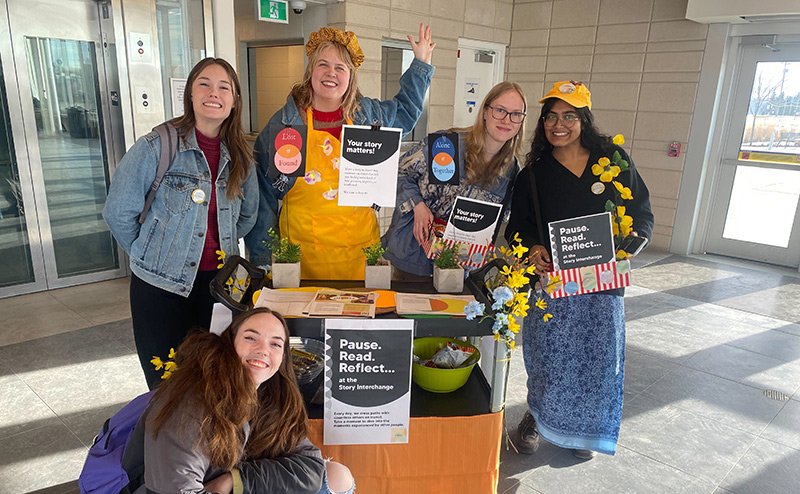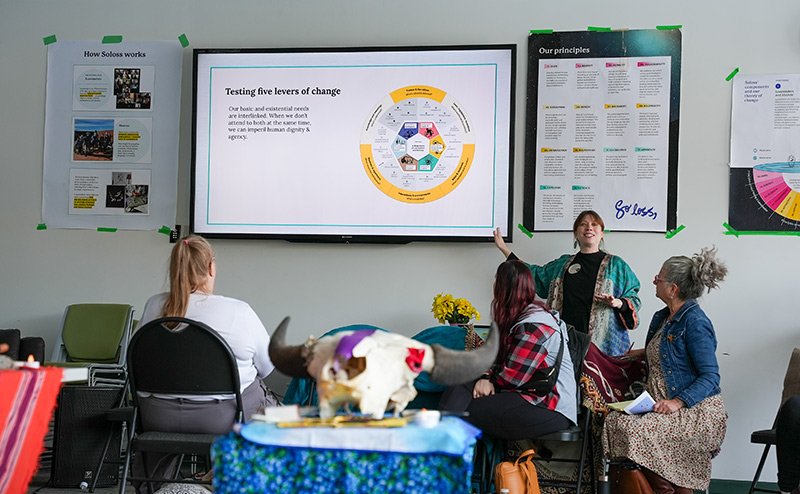Recover was an urban wellness project in Treaty 6 Territory (Edmonton, Alberta) that worked to create opportunities for connection, to help people and places thrive.
Recover began in 2017 and wrapped up in 2024. It was an incredible learning journey with many insights emerging from Recover's research and experience over the years. We now strive to embed these learnings.

It was part of a well-being movement across the globe that:
- Used social innovation
- Examined dominant framing and narratives
- Engaged in human-centered design
- Looked at different ways of using community resources
Recover strove to address the need for connectedness as this is just as critical as housing, food and basic supports.
The 7-year course of Recover was filled with learning and unlearning. The team learned the language of social innovation, to accept different forms of knowledge and learning, and to trust the process and each other. Importantly, they also learned that they were not the experts, but curious co-travellers with fellow Edmontonians on a journey to make our city better together.
We focused on connection as the target outcome - making an intentional effort to keep straight means versus ends. City programs, services and infrastructure are the means to achieve connection outcomes.
We used social research and design (R&D) and tried to understand issues from the perspectives of people at the heart of them. We also worked to deepen our understanding of different knowledge systems, specifically Indigenous knowledge.
We researched and tested new roles and practices that complement or enhance existing practices and services. We paid attention to what worked, what didn’t work, for whom, and under what conditions.
We included people with lived experience from marginalized communities in the creation of the new solutions and built partnerships to strengthen communities’ mutual understanding and respect for each other, and also to create more capacity within communities to nurture well-being.
We strove to create environments where connections could flourish, both on the small scale, between individuals and on the larger scale, through policy change at the institutional and systemic levels.
We worked within a wellbeing framework that emerged from our research and experience. It identified 6 kinds of connection that are at the heart of what it means to be well:
- Connections to body and self
- Connections to friends, family and community
- Connections to the land
- Connections to culture
- Connections to the sacred
- Connections to one’s purpose, or ‘the human project’
Using social research and design (R&D) , we created opportunities for connections to grow and worked to find more balance between meeting material and non-material needs. This is one of the places where long-term transformation lies for communities and people alike.
The framework was designed to help people feel more connected to themselves, the land and others, to build healthier communities and safe, vibrant public spaces.
The definition of well-being as expressed in the well-being framework has been incorporated into the City’s Community Safety and Well-being Strategy.
Rebalancing the Scales
This understanding of well-being has shown just how complex, nuanced and messy creating change can be. It’s opened up more questions than answers, like:
How do we rebalance the language we use? It currently focuses on deficits, on “vulnerable people,” and “social disorder.” Can we start to reframe our narratives and stories with examples of strength, resilience and resourcefulness?
How do we frame problems in both material and non-material terms? Problems are often boiled down to material needs. Can we give more consideration for the need for dignity, purpose and connection?
How do we rebalance solutions? Solutions tend to focus on new programs and services, or on buildings or infrastructure. What if solutions were built around new roles, new rules and designing different interactions in those programs or buildings?
How do we move beyond expressing knowledge in rational and empirical ways? Can we give equal weight to building knowledge through experiences, Indigenous and other ways of knowing?




